 |
 |
 |
| |
NASH and Visceral Fat Tied to Adipose IR Independently of BMI
|
| |
| |
EASL 2020, Digital International Liver Congress, August 27-29, 2020
Mark Mascolini
Nonalcoholic steatohepatitis (NASH) more than doubled the odds of increased adipose tissue insulin resistance (Adipo-IR) in a study of 211 people in Belgium. This association held true independently of age, body mass index (BMI), or diabetes. And more visceral fat correlated with greater Adipo-IR.
Researchers from the University Hospital Antwerp and colleagues at other centers conducted this study of adipose tissue as a metabolism regulator in people with or without NASH. They noted that "adipose tissue acts as an endocrine organ that influences metabolism by releasing adipokines, proinflammatory factors and free fatty acids (FFA), which all contribute to insulin resistance." They conducted this study to determine whether (1) Adipo-IR, (2) plasma FFA, (3) plasma triglycerides, and (4) plasma beta-hydroxybutyrate concentrations are associated with NASH severity.
The research team recruited consecutive adults seen at the Liver Clinic or the Obesity Clinic at the University Hospital Antwerp. Study participants had to have (1) liver steatosis on ultrasound and/or abnormal liver tests and/or features of metabolic syndrome, (2) body mass index below 40 kg/m2, and (3) no other liver disease (including alcoholic liver disease) or type 2 diabetes before screening.
The investigators determined presence of glucose intolerance or type 2 diabetes by oral glucose tolerance test and measured related variables including FFA, Adipo-IR (FFA x insulin), and fat distribution (by CT scan).
Of the 211 study participants, liver histology indicated that 55 people (26%) had no nonalcoholic fatty liver disease (no NAFL), 34 (16%) had nonalcoholic fatty liver (NAFL), and 122 (58%) had NASH. In the no NAFL, NAFL, and NASH groups, age averaged 40.5, 48.2, and 45.5 and proportions of women were 87%, 71%, and 57%. Respective proportions with F2-4 fibrosis (vs F0-1) were 11%, 15%, and 88.5%. The three groups were similar in BMI (average 35.6 kg/m2 overall).
Average triglycerides were lowest in people with no NAFL (128 mg/dL), higher in those with NAFL (141 mg/dL), and highest in those with NASH (176 mg/dL) (P < 0.05 vs NAFL). Adipo-IR averaged 9.0 mmol/L*pmol/L in the no-NAFL group, 10.6 mmol/L*pmol/L in the NAFL group, and 13.5 mmol/L*pmol/L in the NASH group (P < 0.05 vs no NAFL). Adipo-IR also proved significantly greater with steatosis 2-3 vs steatosis 0 (P < 0.05) and with F2-4 fibrosis vs F0-1 (P < 0.05).
Logistic regression adjusted for age, BMI, and glucose intolerance or diabetes determined that NASH more than doubled the odds of increased Adipo-IR (OR 2.5, 95% confidence interval [CI] 1.5 to 4.5, P = 0.0005). Active NASH (ballooning plus lobular inflammation 3 or greater) also more than doubled the odds of higher Adipo-IR (OR 2.6, 95% CI 1.4 to 4.7, P = 0.003). Neither FFA, beta-hydroxybutyrate, nor triglycerides independently predicted increased Adipo-IR.
Increased FFA flux to the liver correlated positively with production of beta-hydroxybutyrate (r = 0.54, P < 0.0001). And higher triglycerides correlated positively with Adipo-IR (r = 0.29, P < 0.0001). CT-measured visceral fat was significantly higher in people with NASH and F2-4 fibrosis than in those with NASH and F0-1 fibrosis or those with no NAFL (P < 0.05 for both). More visceral fat correlated positively with Adipo-IR (r = 0.16, P < 0.02). Peripheral IR and Adipo-IR correlated strongly (r = 0.778, P < 0.0001).
The researchers conclude that increased Adipo-IR is significantly associated with severe NASH independently of BMI. Adipo-IR also correlated with visceral fat and triglycerides. They propose that "dysfunctional adipose tissue is an important feature of [NASH] and potentially a main target for therapy."
Reference
1. Vonghia L, Gaggini M, Verrijken A, et al. Active non-alcoholic steatohepatitis and severe fibrosis are associated to dysfunctional adipose tissue and worsen with adipose tissue insulin resistance independently of body mass index. EASL 2020, Digital International Liver Congress, August 27-29, 2020. Abstract AS161.
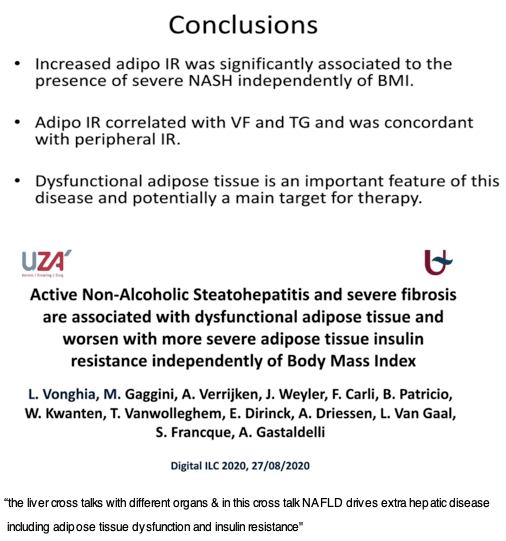
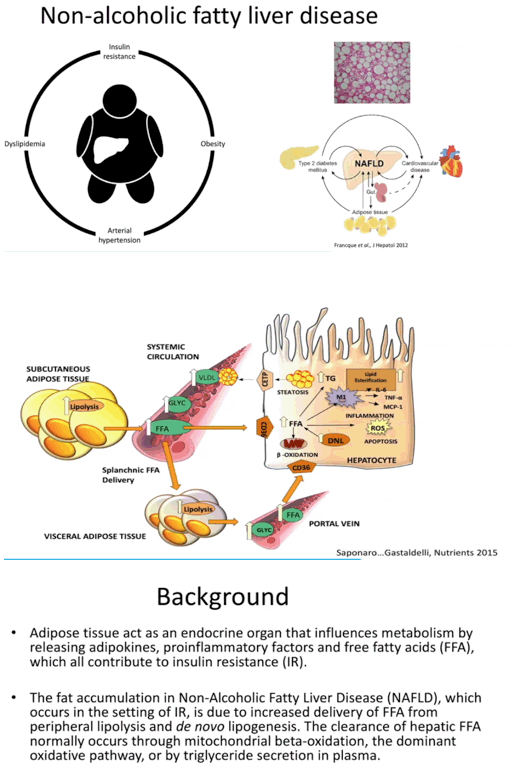

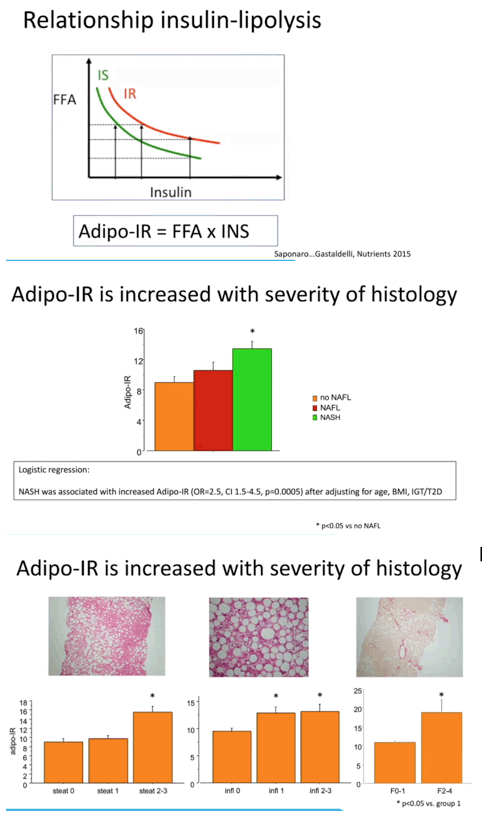

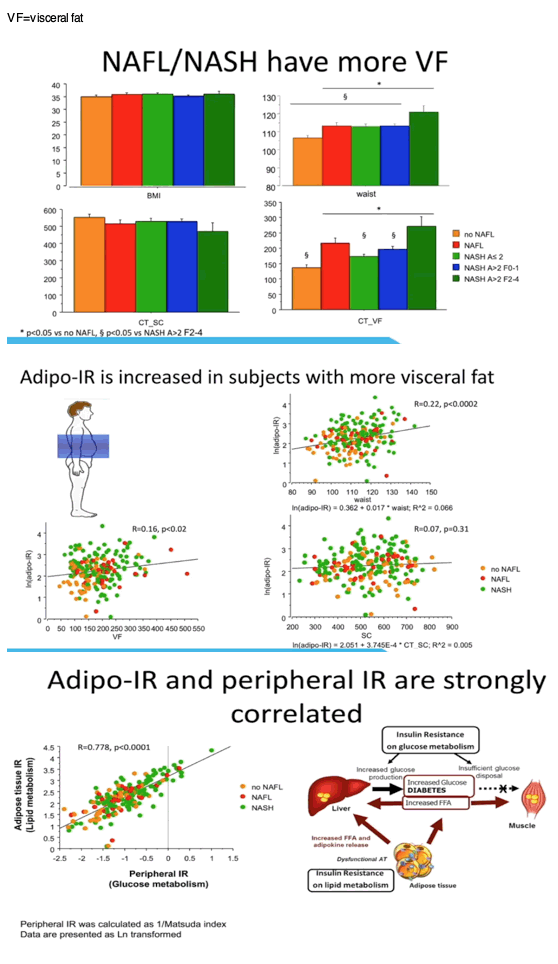
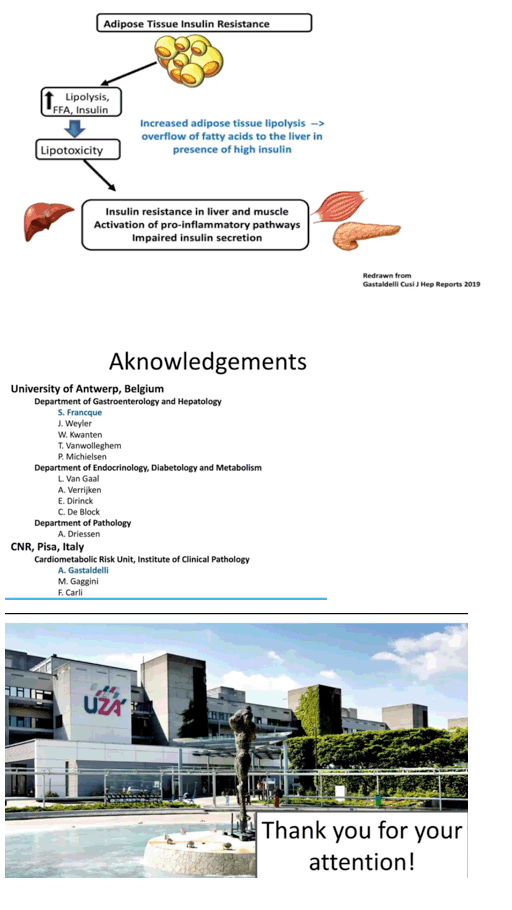
|
| |
|
 |
 |
|
|